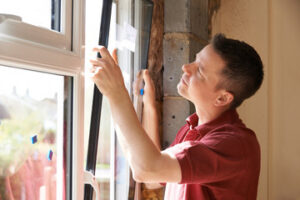Drywall Repair Mesa AZ can be a relatively straightforward do-it-yourself project. Whether you’re fixing nail pops, small holes or cracks, the process is similar.

For nail pops and small dents, Silva recommends using a patch kit with self-adhesive mesh patches. Once applied, the patch is filled with joint compound, sanded and painted.
Small holes, dents, and dings that occur from hanging art or mirrors, from kids or pets playing indoors, or from the removal of large fixtures are easily repaired using drywall compound and a putty knife. A good job can make the repair virtually invisible.
Before you start to fix any drywall damage, sand the area smooth, to ensure that your patching compound will blend in with the wall. This will also help reduce future cracking of the drywall and allow for a more even texture on the wall surface.
If your drywall is damaged by a plumbing leak, electrical problem, or the removal of a fixture, address the cause before you start to patch. This will prevent the hole from becoming a major problem later on, and it will also help your repair last longer.
Medium holes are up to 8 inches wide, and may have jagged or broken edges. You can use a drywall patch kit, or purchase a piece of drywall to replace the damaged section. For best results, you will need to apply several layers of joint compound and sand between applications. This process is known as “feathering” the edges of the repair.
For this type of project, you will need a ladder, power tools, and a few other basic supplies. You will need a tape to use with the drywall patch, as well as sandpaper and a putty knife for applying and smoothing the joint compound. You will also need a hammer to tap the patch into place and a utility knife to cut the necessary size of new drywall.
If the hole is in a corner, you will want to build up a bit of extra drywall behind it, using furring strips (often made of wood) and drywall screws. This will add strength to the wall, and prevent it from collapsing into the hole in the future.
Cracks
Cracks in drywall are more serious than holes and can be caused by structural problems with the house, or can be caused by pressure from outside. Usually, small hairline cracks can be repaired by taping them with mesh tape and filling the cracks in with a little joint compound (mud). For larger cracks you will need to remove the old mud and apply a new coat of mud. For the best results, be sure to sand the crack smooth before painting. This type of drywall repair isn’t for the inexperienced do-it-yourselfer, as it requires a lot of patience and skill to make it look good.
Drywall cracks are typically more difficult to address than nail holes and require a bit more time and effort, but can be successfully done with a few basic tools. When you notice a crack in your drywall, first use an electronic stud finder to locate the studs on both sides of the crack. Then cut away the damaged drywall, if necessary.
Next, install a new piece of drywall using a drywall saw and screw gun. Install the new drywall to the studs and screw it securely into place. Use a utility knife to remove any loose gypsum paper and drywall compound from around the edges of the patch. Apply a new strip of self-adhering drywall tape over the seam, then apply joint compound to cover the tape and fill in the crack (Image 1).
For larger cracks, you will need to remove the existing mud and apply a new coat to ensure that it is strong and smooth before painting. For the best results, sand the crack smooth before applying a second coat of joint compound and sanding again. For really large cracks, you may want to try a paintable elastic crack filler.
Before starting any drywall repair, it is important to thoroughly assess the damage and consider whether there might be other problems in the area, such as moisture or structural issues that need to be addressed. Addressing these problems will help ensure that the repairs last and will prevent recurring damage.
Nail Pops
Nail pops, also referred to as nail heads protruding from your walls or ceiling, are unattractive, particularly when they occur in a prominent location and several in a row. Nail pops aren’t a huge deal in themselves, but they can be a sign of more serious problems like foundation issues. The key is to quickly address these blemishes before they cause more extensive damage to your home.
Nails holding drywall tend to loosen and pop out when wood framing shrinks. This usually happens after the lumber has been stacked and stored in a warehouse for a long time or as moisture changes the wood’s composition. Nails or screws that are held in place by drywall can begin to pop out from the wall or ceiling as the wood shrinks. Once the nails or screws pop, they can create a small dimple on the wall or ceiling.
The good news is that nail pops are usually cosmetic and can be easily fixed. If you find a nail or screw that has popped out, use a utility knife to cut away the joint compound and expose the fastener head. If the screw is a drywall screw, a few light taps with a hammer should drive it back down below the surface. If it is a nail, tap it in slightly deeper. Then, coat the area with a light coat of wallboard compound or “mud” and sand it smooth.
While addressing nail pops may be simple, doing so effectively can be difficult. Whether you’re a DIY homeowner or rely on the services of professional drywall contractors, it is crucial to ensure your repairs are done correctly.
If you don’t do this, the problem will likely resurface. In addition, the underlying issue that is causing the nail or screw to pop will continue to get worse, eventually leading to additional structural concerns, such as door frames and window casings that start to stick. Foundation problems don’t happen overnight and they can cause serious damage to your home if left unattended.
Water Damage
If your drywall has wet spots, it’s time to call in the professionals. Moisture can degrade drywall and wood framing, providing the perfect environment for mold to grow. If the water is stopped before it spreads, a professional restoration company can restore the area and prevent further damage.
Wet spots may be visible on the surface of drywall, or they might feel slightly damp to the touch. If you suspect moisture problems, a quick and simple test is to put your hand on the wall. If you can feel a wet spot, or you see signs of moisture in your home (such as a musty smell), a dehumidifier is an easy and inexpensive way to keep the levels low, and prevent mold growth.
Drywall damage due to water can occur in a variety of ways, from flooding and hurricanes to a burst pipe or condensation from an air conditioner. It’s important to inspect your drywall regularly and address issues as soon as you notice them.
While many homeowners are capable of completing minor repairs, more extensive water damage requires the expertise of a professional. It is also important to note that any drywall repair work should be performed immediately to avoid long-term problems such as mold and mildew.
Whether you have a small hole in your drywall or a large section that needs replacing, the process is similar for both. First, remove the damaged drywall and make sure to save any insulation. Once the wall is dry, a drywall patch kit can be used to fill the hole. Apply a layer of spackle or joint compound over the patch, then use a putty knife to smooth the material and feather the edges so it blends with the wall. When you’re finished, the patch should be sanded and primed to match the surrounding wall. For textured walls, it is also important to practice on a scrap piece of drywall before applying the texture to the repaired area to ensure a seamless look. After the patch is applied and sanded, it’s ready to paint!

